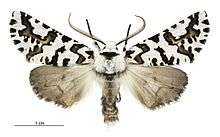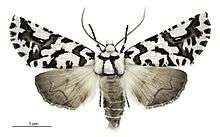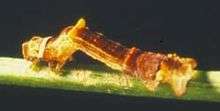Declana atronivea
Declana atronivea, commonly called the North Island lichen or North Island zebra moth, is a moth of the family Geometridae.[3] It is endemic to New Zealand.[2] It is one of only two insect species with asymmetrical wing markings.
| Declana atronivea | |
|---|---|
 | |
| Male specimen | |
 | |
| Female specimen | |
| Scientific classification | |
| Kingdom: | |
| Phylum: | |
| Class: | |
| Order: | |
| Family: | |
| Genus: | |
| Species: | D. atronivea |
| Binomial name | |
| Declana atronivea | |
| Synonyms[2] | |
| |
Taxonomy
D. atronivea was first described by Frances Walker in 1865 as Detunda atronivea.[4]
Description
The larvae have a lumpy appearance and are brown and brownish-white in colour, growing to approximately 30 mm.[5] In the early stages of their life they look similar to a bird dropping when curled on a leaf.[5] When an adult D. atronivea has a wingspan of between 40–45 mm.[3]
This moth is white with dark brown or black markings. It is very similar in appearance to its close relation the South Island lichen moth, Declana egregia, but it has fewer dark markings and does not have the dark edges on the forewing.[5] This gives D. atronivea a more mottled appearance; it also has a black rectangular mark on the back of the thorax.[6]
Hudson noted that D. atronivea "varies considerably in the size and shape of the black markings on the fore-wings, which are often slightly different on the opposite sides, in the same specimen."[7] D. atronivea is notable for being the only one of 180,000 Lepidoptera species with asymmetrical patterning: its wings are not mirror images of each other.[8] It is one of only two species of insect with wing-colour asymmetry; the other is the mantis Tithrone roseipennis.
Distribution and habitat
D. atronivea is found in the North Island[3] and in 1913 was regarded as being rare in Whanganui region but was noted as being very common about Mount Taranaki and Mount Ruapehu.[9] It has also been found in Wellington, Otaki and Napier.[7]
Life stages

The eggs of D. atronivea are laid from the end of October.[7] They are oval in shape, slightly roughened on their surface and start out green in colour, turning a light blue shade covered with purple spots after approximately a week and then to a light purple colour just prior to hatching.[7][9] The eggs are laid singularly and hatch after 11 days.[9] Although the larvae are generally brownish or blackish green in colour they can vary in shade significantly.[7] The pupae inhabit a light coloured cocoon which they form amongst leaves on the surface of the ground.[7] The adults emerge in February and March.[7] Some overwinter as pupae while others transform into adult moths.[5]
Host plant
The host plants of the caterpillars of D. atronivea are Pseudopanax[3] including Pseudopanax arboreus[7] and Pseudopanax crassifolium.[10]
References
- Yu, Dicky Sick Ki. "Declana atronivea (Walker 1865)". Home of Ichneumonoidea. Taxapad. Archived from the original on 7 February 2017. Retrieved 6 February 2017.
- "Declana atronivea (Walker, 1865)". www.nzor.org.nz. Landcare Research New Zealand Ltd. Retrieved 6 February 2017.
- "North Island Lichen Moth". www.landcareresearch.co.nz. Landcare Research New Zealand Ltd. Retrieved 6 February 2017.
- Walker, Francis (1865). List of the Specimens of Lepidopterous Insects in the Collection of the British Museum Part 31-32. London: Trustees of the British Museum. p. 619. Retrieved 6 February 2017.
- Early, John (2009). Know your New Zealand native insects and spiders. Auckland: New Holland Publishers Ltd. p. 138.
- Miller, David (1955). Nature in New Zealand Native Insects. Wellington: A. H. & A. W. Reed. p. 15.
- Hudson, G. V. (1898). New Zealand moths and butterflies. London: West, Newman & Co. pp. 95–96. doi:10.5962/bhl.title.7912. Retrieved 6 February 2017.
- Flux, John (Summer 2017). "Moth markings". Forest & Bird (366): 56.
- Watt, Morris N. (1913). "Descriptions of the Ova of some Lepidoptera of New Zealand". Transactions and Proceedings of the New Zealand Institute. 46: 65–95 – via Biodiversity Heritage Library.
- Spiller, D.; Wise, K. A. J.; Dale, P. S.; Maddison, P. A. (1982). A catalogue (1860-1960) of New Zealand insects and their host plants. Wellington: DSIR Science Information Division. p. 140. ISBN 0477066933. OCLC 10456569.
External links
| Wikimedia Commons has media related to Declana atronivea. |
| Wikispecies has information related to Declana atronivea |